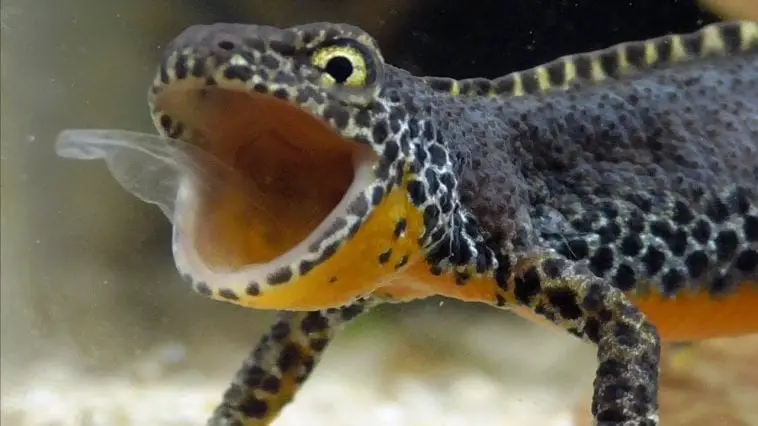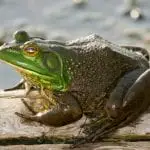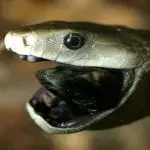Scientific Facts
| Common Name: | Alpine Newt |
| Scientific Name: | Ichthyosaura alpestris |
| Life Span: | Over than 20 years incaptivity |
| Size: | 4.5 inches (female) 41/3 inches (male) |
| Habitat: | Still bodies of water |
| Country of Origin: | Europe |
Physical Description
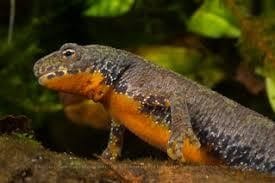
A male alpine newt – Image Source
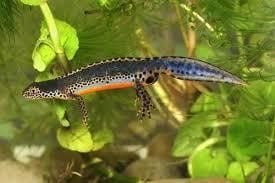
A female alpine Newt – Image Source
Ichthyosaura alpestris or the alpine newt is elegant and colorful, making it fascinating among the other species. It has a rounded head and a slender body. Its tail is a little shorter than its body, and it is compressed laterally. It is sharp too. When the aquatic stage comes, its skin gets very smooth. This newt has five toes and four fingers. Its eyes have gold iris while the pupils are black. No wonder, this makes it so striking.
For the female newts, they have got a round trunk and grows over 4.5 inches in length, whereas the males are squarer in the trunk and grow 4 1/3 inches’ length. Their sexual dimorphism is so obvious in the spring. The males got a low and smooth crest along the vertebrae plus yellowish having black blotches. This is their crest. It is one-tenth of an inch. In addition, they have a rounded and swollen cloaca. Meanwhile, the females possess a slight yellow-orange of the strip that runs along their dorsum.
Throughout the whole year, the coloration of male’s dorsal varies. It could turn grayish, brownish, or bluish; on the other hand, it becomes bright blue in the spring. Along the lower flanks, there is a silvery band having some black spots. These are not found in females. Their dorsum is almost always seen darker than the males. It appears to be brown, gray, or dark blue. By the way, a female’s tail and dorsum are marbled.
One thing they share in common is their orange belly, although it tends to be red or yellow. Normally, their belly spots are rare. The throat can be spotted or plain, depending on the individual or subspecies. It is rare and delicate to find a newt that has black irises and red pupils. This alpine newt is so simple to raise and breed despite being so beautiful.
Range and Habitat
This alpine newt is all over Europe. They in the extreme northern and southern parts of Italy. They are isolated in the north and central Spain. They can also see in Great Britain, North Germany, and Hungary. They are extended until north and east of France to western Ukraine and Greece as well as in the Netherlands, Denmark, Belgium, Romania, the Balkans. Unfortunately, they are absent from Austria and some parts of Slovenia. They have just been introduced by man in the United Kingdom.
Alpine newts generally live in slow or still waters that have full and clear vegetation. Bodies of water like reservoirs, fountains, lakes, swamps, ponds, irrigation canals also serve as a habitat for them. These are mostly found in the deep woods. In North Europe, most of them are in lowlands. They are more terrestrial in the north, while they live in hills and mountains in the southern part. Most of the year, they are aquatic. They can live as high as 8,800 feet in some regions of Albania and Italy.
In terms of temperature, they can tolerate up to 84 degrees F, but don’t think they really live in this type of temperature. They like much colder, in fact. In the winter, they are a little active staying on the frozen surface of lakes. At this season also, they are not so colorful, and their skin gets thicker and velvety and tends to be terrestrial, but they still stay near their habitat.
They stay under piled branches, cairns, moss, basements, fallen trunks, mammal burrows, and more. They are mostly invertebrate eater. This includes springtails, gastropods, and crustaceans. They eat those that fall into the water. They catch their food with the use of their smell and sight. When in search of slow-moving prey, they make use of their olfactory ability, but when starving, they are attracted to the moving prey.
Life Cycle
1) Egg
The eggs are encased in a substance that is gel-like instead of a hard shell. Females release eggs one at a time. they are stored in clusters from a handful to some dozens in size. Adults defend their eggs after they are deposited. Mothers tend to curl their bodies around their eggs for protection, while some wrap the eggs with leaves as camouflage. They measure a millimeter or 2 in diameter. Moms anchor their eggs to the plants underwater.
2) Tadpole
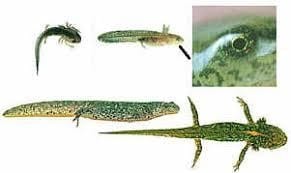
After hatching and being submerged in the water, they become aquatic larvae having tails like fish and gills that are used for breathing under the water. Not all species of newt have the tadpole phase. This phase is short except in the species which are aquatic. Some newts spend their juvenile period as tadpoles and don’t experience the terrestrial stage.
3) Eft
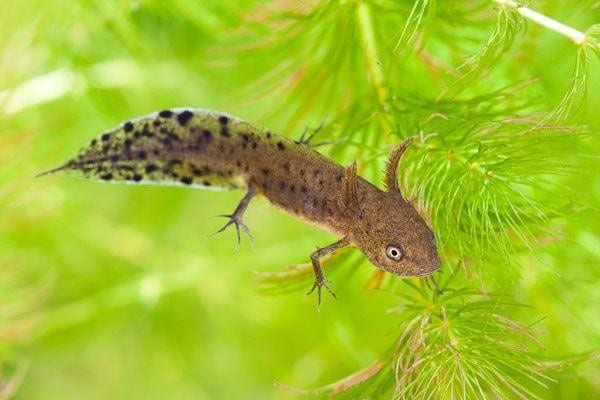
After being a tadpole, they progress to the terrestrial stage. In this stage, they are called efts. The juveniles who are land-bound need an environment with moisture and shade. They hide under fallen leaves, stones, logs, and natural shelter having damp soil.
4) Adult
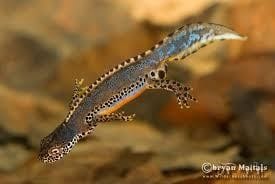
Adults are versatile. Most have wide tails and both legs. Thus they can walk or swim. However, each species has a propensity for either aquatic or terrestrial and spend their time in one of them. Adults spend their time on land and do mating and courting in the water.
Identification
They are similar to the native palmate and smooth newts in terms of size. Females are larger at 12 cm, and males are 10 cm. Both males and females are colorful, having a belly that is bright orange. Their bodies have marble appearance.
Males tend to have bluish and black grey, while females are much browner. Along with their bodies are strips of bright blue adjacent to the orange belly. Males in the breeding season have a low and straight crest with black and white spots
The lifespan of Alpine Newt
In captivity, Alpine Newts can live up to 20 years.
Size
They measure 4 ¾ inches long and have a short tail.
Subspecies
Again, alpine newts are so fascinating for their colors and behavior. Its genus Ichthyosaura has gone through shiftings. Here are the 3 sub-species which are commonly bred and kept in captivity
- I.a. alpestris. This is found in Germany, northeast Italy, Holland, Ukraine, Denmark, Belgium, northern Greece, and Russia. It is 4.5 inches long with normal coloration and throat that lacks spots.
- I.a. apuanus. It is also found in the northeast of Italy and southeast of France. It is 4 inches long and more aquatic than the first one. It spots on the throat and belly.
- I.a. cyreni. This subspecies is found in the mountains of cantabrian in the northwest of Spain. It has a larger head than the two. Its body is more rounded but shorter than the first one.
Here are other recognized subspecies.
- I.a. inexpectatus is found only in some regions of South Italy, particularly in the mountains of Calabria. It has a resemblance to I. a. apuanus, but its belly and throat don’t have spots.
- I.a. montenegrinus lives in Lake Bukumirsko in Montenegro. It is completely neotenous. That means adults keep some of the juveniles’ characteristics. It is 3.5 inches long and similar to I. a. alpestris, but its head is larger and has a specialized moth and vomerine teeth.
- I.a. reiseri is in Bosnia, particularly in Vranika Mountains. This is partially neotenous. Its big is head. The largest can be as long as 6 inches.
- I.a. serdarus lives in Montenegro at Zminicko Lakte. It is similar to I. a. montenegrinus.
- I.a. veluchiensis is in Greece, around Mt. Velouchi and Peloponnesus. This measure 4 3/4, has a short tail. Both sexes have bright coloration during breeding.
Food and Feeding Habits

They are called as voracious eaters. Give snails every other day, but take the shells off. They can have slugs, crickets, earthworms, mealworms, and waxworms.
When they are under the terrestrial period, don’t feed the hibernating ones. If you plan to hibernate those who are in the terrestrial stage, then offer them diced earthworms, crickets, slugs, spiders, crickets, and mealworms. Various diet doesn’t need supplements.
Behavior
Alpine newts always nose for food, interact with their tank mates, and explore. They swim in their aquarium too. Handle them only when needed. Your hands should be wet to protect the mucous that covers them.
In captivity
Alpine newt changes from being aquatic to terrestrial. The European newts are not recommended for beginners. When bred well, they can live for over 20 years.
If you plan to keep them in water the whole year, then that would be possible given that you lower the level of the water when summer comes and keep the temperature of the water having 41 degrees F in winter. Use a 20-gallon aquarium to house them in summer and winter. That is the season for the aquatic stage. Your gallon should have measurements of 28 inches’ length, 14 inches wide and 12 inches tall.
On the bottom, put gravel, lots of plants and some rocks. For your plants, choose from Cabomba caroliniana, Egeria densa, Myriophyllum aquaticum, and Ceratophyllum demersum. For them to haul, include some rocks or floating cork on the surface. This also useful when they transcend from aquatic to terrestrial. The water you will use should be a neutral PH. Using a dechlorinator is the best way, or if you don’t have one, just let the water sit out for the whole day using an open container. The chlorine will then evaporate using the second option. The depth of your water should be from 8 to 10 inches. Do change it partially monthly. Put a water filter on the slowest. Then change, or you may just wash your fiberglass every month.
This amphibian doesn’t really make the enclosure dirty; however, you should keep it tidy still. Cleaning depends on how big your tank is, the number of individuals living, and the presence of the filter. Bigger tanks and fewer animals mean less cleaning. Using a filter and small crustaceans definitely mean lesser cleaning frequency.
The temperature in land and water should not go up 84 degrees F. the best is from 57-71 degrees. When it is difficult to keep this in the summer, find a cold basement, or consider a water cooler. Another choice is to keep them outside in the winter and autumn. Then, let them hibernate in ref having 37 to 44 degrees in the summer. Don’t use thermostat so as not to kill them.
When the tank is near a window, then eliminate using artificial lighting, but the light should not be towards the tank directly. Consider using a single fluorescent tube that emits only 2 % of light. This is to keep the body clock of the newt and keep the plants healthy. You can have it from a pet store.
Seasonally Terrestrial
In the season of winter and autumn, this newt becomes terrestrial for hibernating. 3 to 5 of them can live in a small plastic tank that measures 14 inches’ length and 8 inches wide and 6 inches tall. To achieve optimal condition for hibernating, put dead leaves, water, and a piece of cork. Lower the temperature gradually from 41 lower. The humidity level should be about 90 to 100%. They will be ready to breed 2 or 3 months after. Again, you can keep them in water the whole year, but decrease the level of water in the summer, and in winter, keep it 41 degrees F.
Handling
Let your newt be accustomed to its newfound home before you handle them. Wait for some time before you can handle them little by little. Let them get used to you so there will be lesser stress.
Breeding Alpine
Alpine newts in the wild start their breeding before winter ends or before summer starts. They become sexually mature when they turn 3 or 4 years old. Males maturity takes place faster by 6 months to a year. Males go back to the water before females and then get back to the water; their appearance changes, especially their crest. Both sexes go back to their birthplace when breeding.
However, in habitats having food scarcity, reproduction happens every other year. That’s why feeding them consistently is important. Buy two pairs when you want to breed this. To encourage breeding, house males together to increase competition.
Then, again, lower the temperature to lower than 41 degrees. 2- 3 months are enough to make breeding. The courting has three stages.
Newt Courting
Their courting is very complicated and involves 3 processes. Once a male found a female, he follows and positions in front of her. This phase is the orientation display. This helps them decide if they are reproductive as a pair. The female staying still is followed by the male fanning his tail and begins the static display. This is the 2nd stage.
The male moves his tail to only one side of his body, and the tip is towards the head of the female. Then, the male does a lean-in. He stretches his hind legs and remains suspended for a few minutes to 1 hour. To increase his crest’s height, he shows the cat-buckle. With this position, the approaches the female still fanning his tail and gives her a touch using his tail or flank. These movements hypnotize her. Later, he releases pheromones to start breeding.
The last stage is the spermatophore-transfer display. The male sets a distance from her, so she follows him. He slowly moves, so she touches the tail. Then, he releases 1 to 5 spermatophores, a gelatinous mass having a sperm tip left on the ground. The female is led to the spermatophore by the male. Then he stops her as he stands perpendicular to her. That forms a T shape. Her cloacal lips collect what the male has released.
Newt Egg Care
After 3 to 10 days of mating, you will see the female start laying eggs. It happens typically at night and lasts for one to three months. The eggs measure one-tenth of 1 inch. They can reach one-fourth of 1 inch before they hatch. Mother newts lay egg one by one, but 2 or 3 are laid simultaneously. They love laying eggs on tender leaves of the aquatic plants. The leaves fold around these eggs and keep it. As a result, other newts or predators don’t find it for food. Some use plastic bags having strips. Newts prefer to live one than plastic ones. If there are no leaves found, they lay on the substrate.
Females can lay thirty to five hundred eggs on upper levels of the plants for the reason that oxygen is dissolved into the water when it is a high level. That means then that lower leaves contain lesser oxygen. Mothers tend to use external leaves, for they are easier to be folded around the eggs. After mating, check and cut the leaves that have eggs. Then, move them to another tank. Hatching happens after ten to thirty days.
Newt Larvae Care
The larva having half inches long, has tiny gills but lacks legs. It clings to an object submerged. It has 2 little fleshy strops found near the head and oriented downwards. These strips vanish once the anterior legs show. This larva has pale and yellowish-brown skin and many small dark spots. Its ventral side comes in white color. It has got a dorsal-caudal type of crest. On the ventral part of its tail is a small crest.
In each gallon, don’t keep over 6 larvae. Their water should be deeper than four inches. Use tap water and let it sit to get rid of chlorine and other unwanted elements. Change your water regularly.
After they are hatched, larvae don’t eat yet in the first 2 -3 days, but after they can be fed with salina. Don’t give full shrimp or empty eggs, for it can lead to blocking in the intestine. Use small lab pipette to aspirate the eggs or meshed net to get the nauplii. As they grow, give them bigger nauplii too or bugs and worms.
The larval stage is from 2 to 4 months. it all depends on temperature and availability. Low temperature at 59 degrees slows the development. Keep temperatures from 64-72 degrees and give food two times a day. Give them as much as they can.
When the stage is nearly ending, you will notice some changes. It is time to move them to a secure container well-aerated, having water that is half inches deep. Put small rocks to break the water. After a couple of days, metamorphosis happens, and they will grow longer up to 2 inches.
Young Newt Care
Taking care of juveniles needs more effort and care. They are so small and eat tiny insects that move slowly like young mealworms and crickets. Offer them food once a day with a lot of mealworms or springtails.
You can put a group of 4-5 juveniles in a tank that is 8 inches long, 6 inches wide and 6 inches tall. Use minimal furniture. For the substrate, use absorbent paper towels and plastic glass a hide. No need for a water bowl. Instead, put a shallow bowl for them to keep their heads above the water. mist the enclosure daily and change the substrate alternately.
Housing
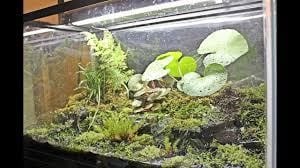
If you intend to keep it outdoors, you can make a vivarium that is a meter-high square wall and cover the structure using netting so that predators cannot get in. cover the bottom for the same reason. Put your vivarium in a shaded area in your garden. Add lots of foods. Their hiding place can be piled stones and decaying woods. Your water has to be large. You can only house them outside if you live to have a mild climate.
When indoors, semi-aquatic, or full aquatic set up are both okay. If there is no filter, put a lot of plants for oxygen supply and for waste absorption as well. The plants will serve as laying places, stones for hiding, and fine gravel for the substrate. Don’t make use of a powerful filter or else they will be agitated. Ferns and mosses are suitable.
Cooling period
The cooling period is important when you want your newt to breed in the next spring. This time they eat less and tend to be less active. They spend it either on land or in the water. you can do the following.
Put them in the refrigerator for 2 to 3 months, having a constant temperature of 2 to 4 degrees Celsius. Another one is to move their enclosure outside in the winter. Just check that they don’t freeze. greenhouse shed or garage is useful. They may not eat. Lastly, utilize a chiller or basement to decrease the temperature. Reduce it from 14 to 17 degrees Celsius. They will eat this time.
Toxic Touch
Many newts come in green, brown or black. This is their way of protecting themselves from predators. Newts having bright colors also serve as a warning to their toxic and that they are not a delicious meal.
Newts secrete toxic mucus. 10 species had a substance called tetrodotoxin and tarichatoxin. TTX or tetrodotoxin is the most poisonous. This is similar to the substance found in pufferfish. This is a powerful neurotoxin that blocks signals that come from the nervous system going to the muscles. In addition, a rough-skinned newt is too deadly that it can kill 25, 000 mice.
Fun Facts
- They occupy the range of habitats in the lowland like gardens, parks, and upland areas that is 2500 above the sea level.
- They are neotenous. It means their entire population, when grown, fully keeps their gills and doesn’t leave the water.
- Alpine newts are alien or just introduced in the UK, so it is lawful to release them in the wild despite being caught or found there.
- When infected with Chytrid fungus, they don’t show any symptoms of the disease and not affected, but the thing is they spread this disease, which can kill a lot of native amphibians.
Impact
This alpine newt is a vector of chytridiomycosis. It means they may tend to be a threat to other native amphibians. The infection affects the native amphibian’s skeleton and skin. Chytrid fungus is waterborne; thus, it is spread between bodies of water. it is quite critical disinfecting equipment and footwear. There are no economic impacts on them yet.
Legislation
It is illegal to spread or release alpine newt in the wild as amended in schedule 9 of the wildlife and countryside act of 1981.
Common Health Problems and Treatments or Prevention
Chytrid
This is an infectious disease which is caused by a fungus. It is the main reason for population decline and extinction among amphibians in most parts of the world. The fungus is named as chytrid fungus. It can kill all the population. Again it is the major reason in the Caribbean, north, south, and Central America and in Australia.
Effects are on the skin tissue and lead to respiration and water uptake problems. It doesn’t cause the death of tadpoles.
What you can do: Report it to groups or organizations.
Symptoms: A large number of dead froglets, newlets, and toadlets after metamorphosis. Skin flaking and lethargy. Dead amphibians are showing no noticeable cause and signs of death or disease.
Predators and Other threats
Adult alpine newts are eaten by birds, rats, snakes, and hedgehog, while the larvae are hunted by fish, adult newts, and dragonflies.
Use and Trade
In some places, there is a wide collection of alpine newts for science and education. For this reason, it has resulted in extinction in some localities in Ukraine. Others collect it for the commercial pet trade. It is said that these are taken out of the wild. Alpine newts are vulnerable to fish breeding and habitat destruction.
How to Care?
A. Habitat and Tank
Use a semi-aquatic type. They do best here. Use a tub or shallow bowl for their swimming. Change the water in the bowl once a week. A small pump makes the water dirty, while a too big one filters out the needed microorganisms. Mist your tank every day. Use moss or mulch as substrates. Put plants, woods, or even rock. A 15 to 20 gallon can house one or two adults. The temperature should be from 68 to 75 F. no need for a special light. Cover all openings so your pet cannot escape.
B. Diet
They are insectivores. They are fed on mealworms, waxworms, and earthworms. Dust their food with calcium.
C. Handling
Give time to adapt and adjust to you and to its new home.
FAQs
How do Alpine newts reproduce?
They begin breeding before winter ends or extended until the start of summer. They get sexually mature at three to four years old. Both sexes breed at the place where they’re born. However, in habitats where food scarcity is present, reproduction happens every other year.
How long do newt eggs take to hatch?
After eggs are laid on leaves underwater, hatching happens a month after. Then, another 3 months for them to be developed into a juvenile.
Are Alpine newts poisonous?
They can be dangerous as they have toxins coming out of their skin. This is a defense mechanism. They could kill a person.
How are newts born?
They are born as eggs. They have 3 life stages.
Can you keep a newt as a pet?
Yes, you can. Put them in tanks of about 20 gallons. Give them a swimming area.
What do Alpine newts eat?
They are a voracious eater. They feed on insectivores like slugs, crickets, slugs, and more.
Can you touch a newt?
They should be handled with caution and care. If you have sores or cuts, don’t touch them. Don’t touch your mouth or eyes too, as you can ingest toxins taken from their skin.
How long are newts pregnant?
Their pregnancy takes 2 to 3 weeks. They lay 7 to 12 eggs a day, which is a total of 400 eggs.
Can a Newt kill a human?
Yes, it can. There was a case of human death after accidentally ingesting toxic into his mouth.
Do newts need a heat lamp?
They are easy to take care of. They like cold water and doesn’t need heating.
How long do newts live for?
In captivity, 6 years is average, but with good condition, they can live for 20 years.
What do you call a baby newt?
A terrestrial juvenile is called an eft.
Can newts live out of water?
Yes, they can. They have the ability to live both in water and on land. Many of them live on land and just go back to the water to breed.
Are newts good for ponds?
In the wild, they live in ponds, and in captivity, they can also adapt to ponds.
Do newts eat Froglets?
Newts do eat tadpoles, so you see fewer frogs in the ponds where newts live.
What time of year do newts lay eggs?
They lay eggs from March to June in the leaves of plants. Put good plants for successful breeding.
Where do newts go in winter?
When winter comes, they move away from their homes. They look for some compost heap, muddy banks, or paving slabs away from frost.
How do you attract newts to a pond?
Allow grasses to grow near the pond or put some aquatic plants. Leaves of the plants will serve as a nest for their eggs.
How do newts get into ponds?
They are guided by wafting the odor of the water.
How big of a tank does a newt need?
A 5 gallon is ideal for 2 newts. They need water and land areas in the enclosure.

